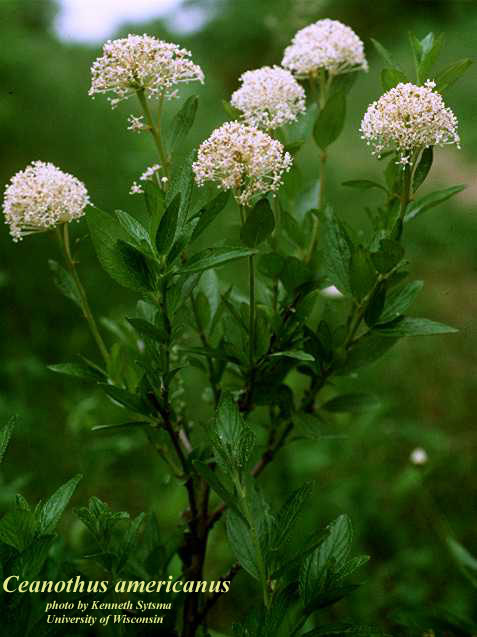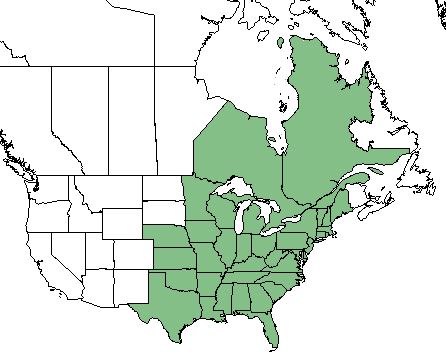Difference between revisions of "Ceanothus americanus"
Lsandstrum (talk | contribs) |
|||
| Line 33: | Line 33: | ||
===Habitat=== <!--Natural communities, human disturbed habitats, topography, hydrology, soils, light, fire regime requirements for removal of competition, etc.--> | ===Habitat=== <!--Natural communities, human disturbed habitats, topography, hydrology, soils, light, fire regime requirements for removal of competition, etc.--> | ||
| − | The ''C. americanus'' is largely found in in sandy soil within woodlands and prairies. <ref name= "USDA"/> Specimens have been collected from sand in open savanna, well drained ridges and slopes, dry sand in loam in pine-oak forests, and in open pine land. <ref name = "FSU herbarium"> URL: http://herbarium.bio.fsu.edu. Last accessed: June 2018. Collectors: Andre F. Clewell, Ro.K. Godfrey, R. Komarek, Loran C. Anderson, Bill Boothe, Marcia Boothe, Annie Schmidt. States and counties: Florida (Leon, Liberty, Wakulla, Washington) Georgia (Thomas, Grady)</ref> Soils that it can be found on include well-drained and mesic loam, sand, or limey soils, sandy loam, sandy, limestone-based, and medium loamy soil.<ref name= "lady bird"/> It is considered a characteristic species of the shortleaf pine-oak-hickory woodlands community.<ref name= "Clewell">Clewell, A. F. (2013). "Prior prevalence of shortleaf pine-oak-hickory woodlands in the Tallahassee red hills." Castanea 78(4): 266-276.</ref> | + | The ''C. americanus'' is largely found in in sandy soil within woodlands and prairies. <ref name= "USDA"/> Specimens have been collected from sand in open savanna, well drained ridges and slopes, dry sand in loam in pine-oak forests, and in open pine land. <ref name = "FSU herbarium"> URL: http://herbarium.bio.fsu.edu. Last accessed: June 2018. Collectors: Andre F. Clewell, Ro.K. Godfrey, R. Komarek, Loran C. Anderson, Bill Boothe, Marcia Boothe, Annie Schmidt. States and counties: Florida (Leon, Liberty, Wakulla, Washington) Georgia (Thomas, Grady)</ref> Soils that it can be found on include well-drained and mesic loam, sand, or limey soils, sandy loam, sandy, limestone-based, and medium loamy soil.<ref name= "lady bird"/> It is considered a characteristic species of the shortleaf pine-oak-hickory woodlands community.<ref name= "Clewell">Clewell, A. F. (2013). "Prior prevalence of shortleaf pine-oak-hickory woodlands in the Tallahassee red hills." Castanea 78(4): 266-276.</ref> ''C. americanus'' responds negatively to soil disturbance in South Carolina's coastal plains.<ref>Brudvig, L.A. and E.I. Damchen. (2011). Land-use history, historical connectivity, and land management interact to determine longleaf pine woodland understory richness and composition. Ecography 34: 257-266.</ref> |
Associated species: ''Pinus echinata'', ''Quercus stellata'', and ''Carya tomentosa''.<ref name= "FSU herbarium"/> | Associated species: ''Pinus echinata'', ''Quercus stellata'', and ''Carya tomentosa''.<ref name= "FSU herbarium"/> | ||
Revision as of 14:31, 13 May 2019
Common Names: New Jersey Tea [1]; Red Root; Indian Tea [2]
| Ceanothus americanus | |
|---|---|

| |
| Photo by the Atlas of Florida Plants Database | |
| Scientific classification | |
| Kingdom: | Plantae |
| Division: | Magnoliophyta - Flowering plants |
| Class: | Magnoliopsida - Dicots |
| Order: | Rhamnales |
| Family: | Rhamnaceae |
| Genus: | Ceanothus |
| Species: | C. americanus |
| Binomial name | |
| Ceanothus americanus L. | |

| |
| Natural range of Ceanothus americanus from USDA NRCS Plants Database. | |
Contents
Taxonomic Notes
Synonyms: Ceanothus intermedius (Pursh)
Varieties: Ceanothus americanus Linnaeus var. intermedius (Pursh) Torrey & A. Gray; Ceanothus americanus Linnaeus var. americanus
Description
C. americanus is a perennial shrub/subshrub of the Rhamnaceae family native to North America.[1] Leaves alternate, oblong-ovate in shape, underside light green and covered with white fine hairs, margins varying from smooth to finely or slightly serrate, and have short petioles with 3 conspicuous palmate veins. Flowers long stalked and clustered on axils of upper leaves, with individual flowers having a long slender tube that is terminated in five folded sepals. The hatchet-shaped petals spread outward when calyx opens, and have a large pistil with 5 stamens that have dark grey colored anthers. Fruit a drupe in sets of 3 that slits into 3 carpels that each contain an elliptical, smooth coated, and brown seed. Root system is a deeply anchored taproot that is stout and reddish in color.[3] Overall, the species usually reaches a height of about 3 feet tall, but can reach up to 5 feet.[4]
Distribution
While it is more commonly found along the coastal plains of the eastern United States and Canada, C. americanus can be found inland as far west as Louisiana. [5]
Ecology
This species as well as others in the Ceanothus genus are nitrogen-fixing plants, meaning they have a mutualism with bacteria in the soil to process nitrogen found in the air and change it into a form useful for plants. This symbiosis is conducted through nodules in the roots of the plant to create a suitable environment for the bacteria.[4]
Habitat
The C. americanus is largely found in in sandy soil within woodlands and prairies. [1] Specimens have been collected from sand in open savanna, well drained ridges and slopes, dry sand in loam in pine-oak forests, and in open pine land. [6] Soils that it can be found on include well-drained and mesic loam, sand, or limey soils, sandy loam, sandy, limestone-based, and medium loamy soil.[4] It is considered a characteristic species of the shortleaf pine-oak-hickory woodlands community.[7] C. americanus responds negatively to soil disturbance in South Carolina's coastal plains.[8]
Associated species: Pinus echinata, Quercus stellata, and Carya tomentosa.[6]
Phenology
C. americanus has been observed flowering between April and July with peak inflorescence in May. [9]
Seed bank and germination
For propagation, seeds should be planted in late fall or early winter for best results.[10] Other methods include scarification by soaking the seeds in hot water and then in cooling water for at least 24 hours, and stratifying seeds between 60 and 90 days at 41 degrees.[4]
Fire ecology
C. americanus has been observed in annually burned pineland savannas.[6] It has a high tolerance to drought and fire is a management technique for the spread of the species.[1] It is adapted to fire through being topkilled yet vigorously resprouts in response to fire from the undamaged rootstock.[3] With reoccurring fire, it can become quite a dominant species along with prairie grasses.[10] It also has the ability to colonize burned sites where it was absent or rare before the fire.[11] Seasonality of burn does not seem to matter much, but one study found winter burns to have the most abundance of the species.[12] Another study found that C. americanus produces the most flower stems with annual burning regiments as well as late season burns, and flower stems were significantly low after early season and growing season burns.[13]
Pollination
Bees may collect pollen from the plant and other insects such as butterflies and moths may just collect nectar.[1] It is a species of special value to native bees since it attracts such a large number.[4] Known pollinators of C. americanus include Apis mellifera, Bombus griseocollis, Bombus impatiens, Ceratina dupla, Hylaeus mesillae, Hylaeus affinislmodestus, Augochlorella aurata, and Lasioglossum foveolatum.[14] The Karner blue butterfly (Lycaeides melissa samuelis) has also been observed to visit the plant for nectar, and flies in the Syrphidae and Tachinidae (Diptera) families have been collected on the flowers.[15][16]
Use by animals
It averages to 10-25% of the diet for large mammals, and 2-5% of the diet for terrestrial birds.[17] The leaves are browsed on by rabbit, deer, and elk, and the fruit is eaten by quail and turkey. It is a larval host for the spring azure (Celastrina ladon), the summer azure (Celestina neglecta), and the mottled duskywing (Erynnis martialis).[3][4] As well, it is a host plant for the New Jersey tea inchworm (Apodrepanulatrix liberaria), the broad-lined erastria (Erastria coloraria), and moths in the Stigmella genus. The mottled skipper (Erynnis martialis) is a specialist for this plant species.[18] It also supports conservation biological control through attracting predatory or parasitoid insects that in turn prey on pest insects.[4] Historically, Native American tribes in the Missouri River region utilized the leaves to make tea and the roots as fuel on their hunting trips. Other tribes in the Great Lakes Bioregion acclaimed it to have great success for treatment of bowel issues. Medicinally, New Jersey tea was used by physicians due to it being a strong astringent, and recently was discovered to have a blood-clotting agent within the roots of the plant.[3]
Diseases and parasites
This species can acquire leaf spot and powdery mildew, but foliar disease is not really a problem for this particular species.[3] C. americanus is a host species for Jepson's dodder (Cuscuta jepsonii).[19]
Conservation and Management
C. americanus is listed as threatened by the Maine Department of Conservation.[1] For management that is interested in promoting the species, fire regiments is the best tool. This particular species cannot be exposed to temperatures below negative 28 degrees Fahrenheit.[3]
Cultivation and restoration
Photo Gallery
References and notes
- ↑ 1.0 1.1 1.2 1.3 1.4 1.5 USDA Plant Database
- ↑ [Thirty-Third Annual Report of the Bureau of American Ethnology, to the secretary of the Smithsonian institution, 1911-1912]
- ↑ 3.0 3.1 3.2 3.3 3.4 3.5 Wynia, R.L. 2010. Plant fact sheet for New Jersey tea (Ceanothus americanus). USDA-Natural Resources Conservation Service, Manhattan Plant Materials Center. Manhattan, KS 66502.
- ↑ 4.0 4.1 4.2 4.3 4.4 4.5 4.6 [[1]] Lady Bird Johnson Wildflower Center. Accessed: April 2, 2019
- ↑ Weakley, A. S. (2015). Flora of the Southern and Mid-Atlantic States. Chapel Hill, NC, University of North Carolina Herbarium.
- ↑ 6.0 6.1 6.2 URL: http://herbarium.bio.fsu.edu. Last accessed: June 2018. Collectors: Andre F. Clewell, Ro.K. Godfrey, R. Komarek, Loran C. Anderson, Bill Boothe, Marcia Boothe, Annie Schmidt. States and counties: Florida (Leon, Liberty, Wakulla, Washington) Georgia (Thomas, Grady)
- ↑ Clewell, A. F. (2013). "Prior prevalence of shortleaf pine-oak-hickory woodlands in the Tallahassee red hills." Castanea 78(4): 266-276.
- ↑ Brudvig, L.A. and E.I. Damchen. (2011). Land-use history, historical connectivity, and land management interact to determine longleaf pine woodland understory richness and composition. Ecography 34: 257-266.
- ↑ Nelson, G. PanFlora: Plant data for the eastern United States with emphasis on the Southeastern Coastal Plains, Florida, and the Florida Panhandle. www.gilnelson.com/PanFlora/ Accessed: 18 MAY 2018
- ↑ 10.0 10.1 Hurteau, M. D. (2006). Plant Guide: New Jersey Tea Ceanothus americanus. N.R.C.S. United States Department of Agriculture. Davis, CA.
- ↑ Hutchinson, T. (2005). Fire and teh herbaceous layer of eastern oak forests. F. S. United States Department of Agriculture, Northern Research Station: 136-149.
- ↑ Kush, J. S., et al. (2000). Understory plant community response to season of burn in natural longleaf pine forests. Proceedings 21st Tall Timbers Fire Ecology Conference. Fire and forest ecology: innovative silviculture & vegetation management, Tallahassee, FL, Tall Timbers Research, Inc.
- ↑ Pavlovic, N. B., et al. (2011). "Short-term effects of burn season on flowering phenology of savanna plants." Plant Ecology 212: 611-625.
- ↑ Grundel, R., et al. (2011). "A survey of bees (Hymenoptera: Apoidea) of the Indiana Dunes and Northwest Indiana, USA." Journal of the Kansas Entomological Society 84(2): 105-138.
- ↑ Grundel, R., et al. (2000). "Nectar plant selection by the Karner blue butterfly (Lycaeides melissa samuelis) at the Indiana Dunes National Lakeshore." The American Midland Naturalist 144(1): 1-10.
- ↑ Tooker, J. F., et al. (2006). "Floral host plants of Syrphidae and Tachinidae (Diptera) of central Illinois." Annals of the Entomological Society of America 99(1): 96-112.
- ↑ Miller, J.H., and K.V. Miller. 1999. Forest plants of the southeast and their wildlife uses. Southern Weed Science Society.
- ↑ Wagner, D. L., et al. (2003). "Shrubland Lepidoptera of southern New England and southeastern New York: ecology, conservation, and management." Forest Ecology and Management 185: 95-112.
- ↑ Costea, M., et al. (2006)."Taxonomy of the Cuscuta indecora (Convolvulaceae) complex in North America." SIDA Contributions to Botany 22(1): 209-226.